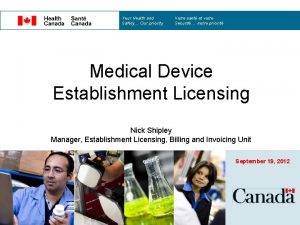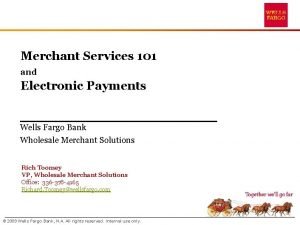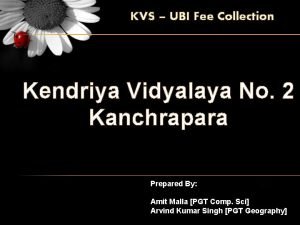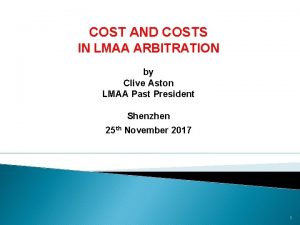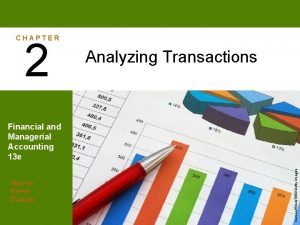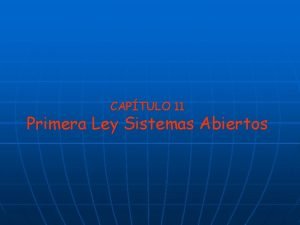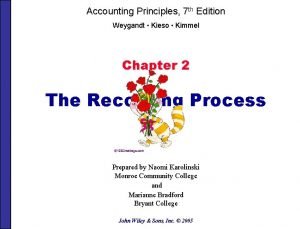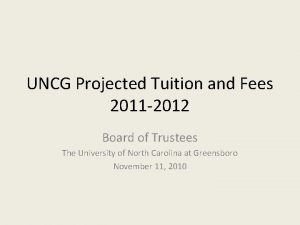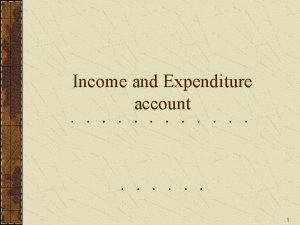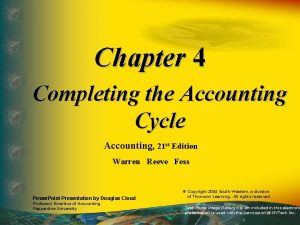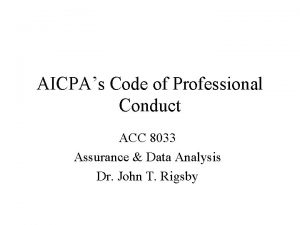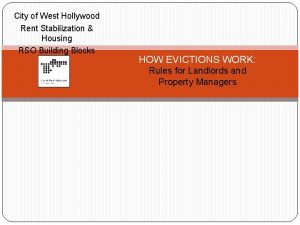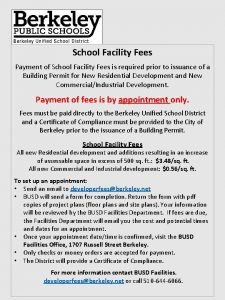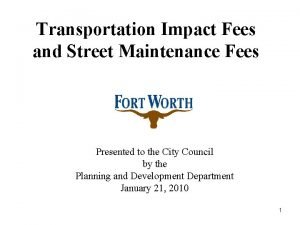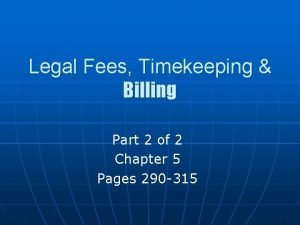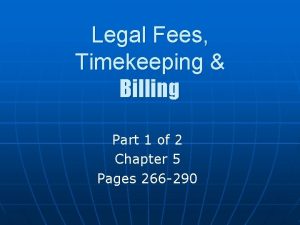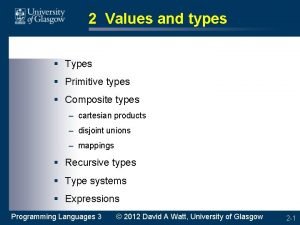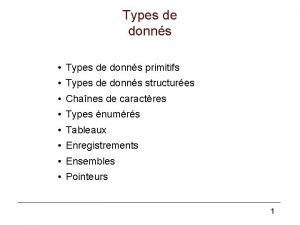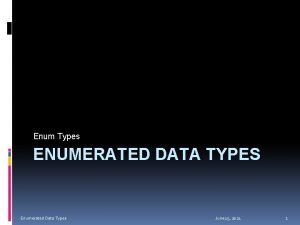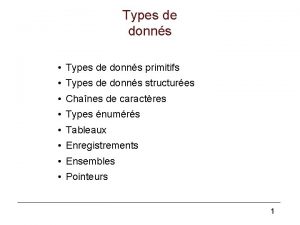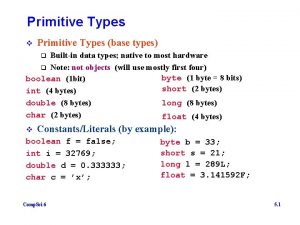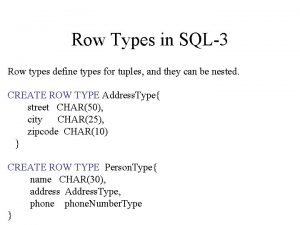Chapter 6 Legal Fees 1 Types of Legal










































- Slides: 42

Chapter 6 Legal Fees 1

Types of Legal Fees Retainer Hourly Flat Contingency Statutory Combination 2

Ethical Limits of Legal Fees must be reasonable Fees must not be unconscionable

Reasonable Fee Factors Experience, reputation, and ability of the lawyers Novelty or difficulty of case Other Employment Opportunities Amount Involved and Results Obtained Time and Labor Required Client’s informed consent to the fee Customary Fees Professional Relationship with Client 4

Types of Retainer Fees True Retainer Nonrefundable Chargeable Nonrefundable Nonchargeable Refundable Chargeable 5

Hourly Rate Fees computed by multiplying attorney or paralegals hourly rate time the number of hours Most common type of fee May be used for most all types of cases

Blended Hourly Rates Blended hourly rates are an average of each timekeeper’s hourly rate Attorney Associate Paralegal Total $300 per hr $200 per hr $100 per hr $600 3 = $200 per hr 7

How to Determine Hourly Rates Salary + Overhead + Profit Billable hours = Hourly Rate $175, 000 (salary) + $87, 500 (Overhead) + $48, 750 (profit) = $311, 250 1, 500 (billable hours) = $208 per hour 8

Another Method to Determine Billing Rates Determine estimated total overhead and profit for firm for one year Determine number of billing attorneys and paralegals and target billing rate for each Estimate reasonable billable hours (1, 500) per year Determine gross billings for the year Adjust the rate, the number of hours or amount of overhead and profit

Contingency Fees Fee is dependant or “contingent” on the outcome of the case Can be used is variety of cases but most common in Personal injury Collection Malpractice Ethical restrictions in Domestic Relations and Criminal Cases

Contingency Fee Statutory Requirements: Fee agreement must be in writing Must include how costs are determined Special Rules for MICRA Actions Must use net recovery method Limits on costs that may be charged Medical care and office overhead not deductable 11

Calculating a Contingency Fee Gross Fee Method Judgment $15, 000 Attny’s fee (1/3) - 5, 000 Subtotal $10, 000 Costs - 1, 000 Total to Client $9, 000 Total to Attorney $6, 000 12 Net Fee Method Judgment Costs Subtotal $14, 000 Attny’s fee (1/3) Total to Client $9, 333 Total to Attorney $15, 000 - 1, 000 - 4, 667 $5, 667

Variations on Contingent Fee Arrangements Percentage increase at various times in the case Sliding scale – fee decreases as recovery increases Reverse contingent fee for defense Based on the amount the client saves Combination of hourly rate and contingent fee Client agrees to pay hourly rate – may be reduced rate Attorney entitled to a percentage of the recovery Client may be entitled to credit for fees paid

Reverse Contingency Fee Based on the difference between the amount at issue and the amount of final recovery Used by defense firms Amount of potential liability: Amount of recovery: Fee: 1/3 of savings: $100, 000 14 $500, 000 $200, 000 $300, 000 =

Contingency/Hourly Combination Client agrees to pay firm hourly at $200 per hour Client agrees to pay one-third contingent fee based on recovery less hourly rate paid Firm bills and client pays: $35, 000 in hourly fees Case settles for $1, 000 Attorney’s fee = 1/3 of $1, 000 $333, 333 Less: Hourly fees paid 35, 000 Net Fee to Attorney

Types of Fixed or Flat Fees Per Case Per Service Fee covers the services regardless of outcome Typical for routine services Estate planning, corporate 16 formation criminal, divorce, bankruptcy

Determining Flat Fees Factors considered are the: Time it takes to complete a case Timekeeper’s hourly rate Attorneys time 1 hr. @ $200 Paralegal’s time 3 hrs. @ $100 = $300 $200 + $300 = $500 The flat fee should be $500 17

Statutory Fees are set by a statute Most common statutory fees Probate Cases Also, attorneys fees that can be charged in default judgments Set forth in local court rules

Statutory Fees – California Probate Code 4% of the first $100, 000 3% of the next $100, 000 2% of the next $800, 000 1% of the next $9, 000 ½% of the next $15, 000 Over $25, 000 – reasonable fee determined by the court 19

Calculation of Probate Fees Estate is determined to have a value of $5, 000 Fee calculated as follows: 4% of first $100, 000 3% of next $100, 000 2% of next $800, 000 = = = $ 4, 000 $ 3, 000 $ 16, 000 = $ 63, 000 1% of next $4, 000 40, 000 Total statutory fee

Combination Examples 20% contingency plus $150 an hour Hourly billings may be credited against recovery $1, 500 flat fee plus 25% contingency Nonrefundable (true) retainer plus hourly billings 33 1/3% contingency plus $5, 000 premium depending on case success (ie. recovery over $100, 000) Capped fee – total fees not to exceed a specified amount Must consider what happens if the fees exceed the cap 21

Firms also Charge for Costs Advanced Filing Fees Faxes Expert witness fees Long distance Deposition costs telephone calls Postage Supplies Outside services Appraisal fees Photocopies Travel and meals 22

Other Fees and Charges Secretaries Clerks Messengers Temporary employees Fixed percentage of monthly fees for “overhead” 23

Lodestar and Multipliers Lodestar is based on the amount of hours reasonably spent and applying the attorney’s hourly rate thereto Multiplier compensates the attorney for risk factors 24

Types of Liens Attorney’s Lien - lien on a judgment or other recovery Created by the written fees agreement Most often seen in contingent fee agreements Retaining Lien - lien on client’s papers, money, or other property in attorney’s possession Ethical issues regarding enforcement of lien Other Lien - Promissory note secured by a deed on the client’s real property Ethical issues 25

Paralegal Ethics Paralegals may not set fees. Paralegals should not quote fees. Attorneys cannot share fees with Paralegals. 26

Chapter 7 Timekeeping 27

Hours are Placed in Two Categories Billable hours Directly applied to clients’ matters 75% to 85% of the day Nonbillable Hours Not applied to clients’ matters. 2 types exist: creditable and noncreditable 28

Creditable Nonbillable Hours Serving on law firm committees Pro bono work Management functions Administrative tasks Training 29

Noncreditable Nonbillable Hours Educational activities Personal matters Association work 30

Tenths of an Hour 1 -6 minutes. 1 7 -12 minutes. 2 13 -18 minutes. 3 19 -24 minutes. 4 25 -30 minutes. 5 31 31 -36 minutes. 6 37 -42 minutes. 7 43 -48 minutes. 8 49 -54 minutes. 9 55 -60 minutes 1. 0

Seven Purposes of Time Records Billing clients Recovery and justification of fees Compensating hourly employees Calculating employee productivity Firm planning Monitoring “Work in Process” Projecting profitability Forecasting income 32

Time Sheet Information Timekeeper’s name Date File name Client name or number File number Amount of time expended Description of work 33

Time Sheet Entries Not Descriptive Review file Conference w/attorney Telephone call Research Worked on computer 34 Descriptive Review answers to interrogatories Conference w/attorney re trial notebook Telephone call to client re deposition Research fraud issues on breach of contract Inserted discovery responses in discovery database

Work Description Codes C/W Conference with P Preparation of CT Court trial R Research CH Court hearing R 1 Review pleadings D 1 Draft pleadings R 2 Review D 2 Draft correspondence D 3 Draft memorandum D 4 Draft other DP Deposition N/C Nonchargeable 35 correspondence R 3 Review memorandum R 4 Review other RV Revision of TC Telephone conference

Billing Process Timesheets/records prepared by attorney/paralegal Data entry into time and billing program Pre-bill generated for review Final bills generated Management reports generated and mailed Aged accounts receivable Attorney/paralegal productivity reports Case type productivity reports “Work in process” reports

Time Records in Contingency Cases and Other Types of Fees Contingency Fee Cases Recover fees in fee disputes Calculate the profitability of a case Determine a case’s settlement value Calculate the amount of lien if terminated Probate Cases Flat Fee Cases 37

Corporate Legal Departments Use Time Records Bill “clients” Management reports Justify additional staff and budget increases Court-awarded legal fees 38

Government Legal Offices Use Time Records Management reports Provide statistics Prepare budgets 39

Paralegal Timekeeping Ethics Do not bill clients for work not performed Do not “pad” time sheets Do not double bill Remember: It is the supervising attorney’s responsibility to make the decision to charge or not charge a client. 40

Timekeeping Tips Keep a time sheet handy Record the largest amount of time Record the time when it is spent Do NOT estimate time Be accurate Be descriptive and concise Record all time including nonbillable time Develop To-Do lists 41

Computerized Time Accounting There are many time and billing computer programs available specifically for law firms. Saa. S – Software as a Service Applications are hosted by a vendor Made available to customers via a network Vendor provides technical operation, maintenance and support Vendor charges a monthly fee 42
 Zeta phi beta shield meaning
Zeta phi beta shield meaning Mdel fees
Mdel fees Vredekloof primary school fees
Vredekloof primary school fees Fees arranged waterloo
Fees arranged waterloo Adv vinod sampat
Adv vinod sampat Portland state university tuition
Portland state university tuition Wells fargo merchant
Wells fargo merchant Ubi fee verification
Ubi fee verification Oakridge secondary school ib program
Oakridge secondary school ib program Fidelity trustee fee schedule
Fidelity trustee fee schedule Little flower primary school thohoyandou
Little flower primary school thohoyandou Lmaa fees
Lmaa fees Fees earned journal entry
Fees earned journal entry Fees termodinamica
Fees termodinamica Achd impact fees
Achd impact fees Fees earned journal entry
Fees earned journal entry What is tuition
What is tuition Uenr today
Uenr today Human academy japanese language school review
Human academy japanese language school review Dumas noon lions club
Dumas noon lions club Mount litera zee school besa nagpur
Mount litera zee school besa nagpur Leading university sylhet tuition fees
Leading university sylhet tuition fees Donation in income and expenditure account
Donation in income and expenditure account Dmc trade
Dmc trade Swapd fees calculator
Swapd fees calculator Computer society of india logo
Computer society of india logo Dr cr balance sheet
Dr cr balance sheet Fees earned debit or credit
Fees earned debit or credit What is considered immediate family
What is considered immediate family The expense recognition principle aims to record
The expense recognition principle aims to record Pcl5 molecular geometry
Pcl5 molecular geometry Betterment hsa optum
Betterment hsa optum Change of land use hmda
Change of land use hmda Iaems
Iaems Mendel university fees
Mendel university fees Leo 51 form
Leo 51 form Maths lit finance grade 11
Maths lit finance grade 11 Kw greensheet
Kw greensheet Ihrmp fees
Ihrmp fees Flower of may site fees
Flower of may site fees Schil court fees
Schil court fees West hollywood rso
West hollywood rso What's the best strategy for avoiding atm fees?
What's the best strategy for avoiding atm fees?

